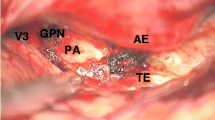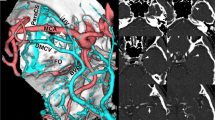Abstract
The drainage of the superficial middle cerebral vein (SMCV) is classified into four subtypes. The sphenobasal vein (SBV) drains from the SMCV to the pterygoid venous plexus at the temporal skull base. Epidural procedures in the standard anterior transpetrosal approach (ATPA) may damage the route of the SBV. We report a case in which modified surgical procedures via the ATPA were used to preserve the SBV. A 45-year-old man complained of right facial pain. Magnetic resonance images revealed a right cerebellopontine tumor suggestive of an epidermoid cyst. Right carotid angiography revealed that the SMCV drained into the pterygoid venous plexus via the SBV. The convexity dura mater of the temporal lobe was cut and the anterior part of the temporal lobe was retracted subdurally. The SBV was visualized from the subdural side. The basal dura mater of the temporal lobe posterior to the SBV was cut and the posterior part of the temporal lobe was retracted epidurally. After dissecting the dura mater medial to the greater petrosal nerve and to the edge of the petrous apex, the petrous apex was exposed and drilled out without injuring the SBV. The superior petrous sinus and the tentorium were cut. The tumor compressed the root exit zone of the trigeminal nerve. The tumor was grossly totally removed. The modified ATPA (epidural anterior petrosectomy with subdural visualization of the SBV) is effective in preserving the SBV.






Similar content being viewed by others
References
DiChiro G (1962) Angiographic patterns of cerebral convexity veins and superficial dural sinuses. Am J Roentgenol 87:308–321
Dolenc VV (1994) Frontotemporal epidural approach to trigeminal neurinomas. Acta Neurochir (Wien) 130:55–65
Dolenc VV (2003) Petroclival meningiomas. In: Microsurgical anatomy and surgery of the central skull base. Springer, New York, pp 185–192
Doyon DL, Aron-Rosa DS, Ramee A (1974) Orbital veins and cavernous sinus. In: Newton TH, Potts DG (eds) Radiology of the skull and brain: angiography. Mosby, Saint Louis, pp 2220–2254
Hacker H (1974) Normal supratentorial veins and dural sinus. In: Newton TH, Potts DG (eds) Radiology of the skull and brain: angiography. Mosby, Saint Louis, pp 1851–1877
Hayashi N, Sato H, Tsuboi Y, Nagai S, Kuwayama N, Endo S (2010) Consequences of preoperative evaluation of patterns of drainage of the cavernous sinus in patients treated using the anterior transpetrosal approach. Neurol Med Chir (Tokyo) 50:373–377
Ichimura S, Yoshida K, Sutiono AB, Horiguchi T, Sasaki H, Kawase T (2010) Greater petrosal nerve schwannomas—analysis of four cases and review of the literature. Neurosurg Rev 30:477–482
Inoue T, Rhoton AL Jr, Theele D, Barry ME (1990) Surgical approaches to the cavernous sinus: a microsurgical study. Neurosurgery 26:903–932
Jones FW (1950) Buchanan’s manual of anatomy. Bailliere, Tindall and Cox, London, p 262
Kawase T, Shiobara R, Toya S (1991) Anterior transpetrosal–transtentorial approach for sphenopetroclival meningiomas: surgical method and results in 10 patients. Neurosurgery 28:869–876
Kawase T, Toya S, Shiobara R, Mine T (1985) Transpetrosal approach for aneurysms of the lower basilar artery. J Neurosurg 63:857–861
Oka K, Rhoton AL Jr, Barry M, Rodriguez R (1985) Microsurgical anatomy of the superficial veins of the cerebrum. Neurosurgery 17:711–748
Padget DH (1956) The cranial venous system in man in reference to development, adult configuration, and relation to the arteries. Am J Anat 98:307–355
Suzuki Y, Matsumoto K (2000) Variations of the superficial middle cerebral vein: classification using three-dimensional CT angiography. Am J Neuroradiol 21:932–938
Tanoue S, Kiyosue H, Okahara M, Sagara Y, Hori Y, Kashiwagi J, Mori H (2006) Para-cavernous sinus venous structures: anatomic variation and pathologic conditions evaluated on fat-suppressed 3D fast gradient-echo MR images. Am J Neuroradiol 27:1083–1089
Toda M, Yoshida K, Kawase K (2010) Subtemporal approach—venous drainage and surgical anatomy. Jpn J Neurosurg 19:742–752 [in Japanese]
Wolf BS, Huang YP, Newton CM (1963) The superficial sylvian venous drainage system. Am J Roentgenol 89:398–410
Yamakami I, Hirai S, Yamaura A, Ono J (1988) Venous system playing a key role in transpetrosal approach. No Shinkei Geka 26:699–707 [in Japanese]
Author information
Authors and Affiliations
Corresponding author
Additional information
Comments
Imad N. Kanaan, Riyadh, Saudi Arabia
Prerequisite for the successful design and selection of the skull base approach is its short and direct access to the target coupled with maximal exposure of the offending pathology and minimal invasiveness to surrounding vital neurovascular structures. Promotion of surgical approaches during the past three decades was facilitated by the introduction of modern imaging techniques (CT, MRI) and evolution of high-quality neurosurgical equipment. In our contemporary neurosurgical practice, the anterior transpetrosal approach has become a popular avenue for the resection of lesions confined to the posterior cavernous sinus, tentorial edge, ventral brainstem, and medial upper petroclival region. This approach can be used solo or in combination with other adjacent approach to enhance exposure. One of its major pitfalls reported in the literature is the severe brain swelling induced by excessive retraction of the temporal lobe or compromise of important venous drainage such as damage to the vein of Labbé or other important venous channels in the region. The authors nicely highlight the road map of venous outflow at the skull base using 3D-CTV as a noninvasive method and elegantly describe an important technical note using sub- and epidural anterior transpetrosal approach to maintain the integrity of the sphenobasal vein during such intervention. The readers should be aware of the fact that the sphenobasal vein may represent an important draining channel of the brain in this region and its compromise may lead to unpredicted catastrophic outcome. Finally, as a recommendation for the surgical resection of epidermoid cysts, we have recently adopted a simpler and less invasive method, performing endoscopic-assisted microsurgical resection with excellent results.
Kenji Ohata, Osaka, Japan
In this article, the authors demonstrated their surgical technique for the preservation of sphenobasal veins when using the anterior transpetrosal approach. This surgical modification of the anterior transpetrosal approach is quite beneficial to prevent venous congestion caused by interruption of the venous flow from the superficial sylvian veins to the sphenobasal veins around the foramen ovale, as an unexpected result of epidural exposure of the petrous apex and third division of the trigeminal nerve. The case they presented here had a well-developed collateral connection between the vein of Labbé and the superficial sylvian vein. Therefore, there may be some arguments whether this surgical modification is necessary for the patient or not. Nevertheless, this article is quite informative and helpful when a dominant venous flow from the sylvian vein to the sphenobasal vein is encountered in the anterior transpetrosal approach.
Sunil Manjila and Nicholas C. Bambakidis, Cleveland, USA
Extradural procedures in an anterior transpetrosal approach (ATPA) may interrupt the route of drainage from the superficial middle cerebral veins (SMCVs) and the cavernous sinus to the pterygoid venous plexus at the temporal skull base. In this interesting article, the authors have demonstrated a special technique of subdural visualization of the sphenobasal vein during the epidural anterior petrosectomy to avoid catastrophic venous bleeding, congestion, and infarctions in the temporal lobe. This early visualization technique can be particularly useful in cases with prominent sphenobasal vein associated with a massive pterygoid plexus itself or a dominant venous flow from the sylvian vein into the sphenobasal vein. The authors have used conventional angiogram and 3DCT venogram to visualize venous anatomy clearly. We routinely do not perform an angiogram prior to resection of CP angle epidermoids of this size and in this location, unless there is an atypical or complex venous drainage pattern noted on the preoperative MR imaging. Although the authors have done a fine job with the preservation of the temporal lobe during surgery, it is prudent to leave a cautionary note that the subdural retraction of the anterior temporal lobe and the extradural elevation/retraction of the posterior temporal lobe can increase the retraction burden from manipulating both anterior and posterior temporal lobe with multidirectional forces. Furthermore, this approach is applicable only for sphenobasal type of venous drainage only, not other types like in sphenoparietal sinus pattern of venous drainage.
Rights and permissions
About this article
Cite this article
Ichimura, S., Yoshida, K., Kagami, H. et al. Epidural anterior petrosectomy with subdural visualization of sphenobasal vein via the anterior transpetrosal approach—technical case report. Neurosurg Rev 35, 609–614 (2012). https://doi.org/10.1007/s10143-012-0405-2
Received:
Revised:
Accepted:
Published:
Issue Date:
DOI: https://doi.org/10.1007/s10143-012-0405-2




